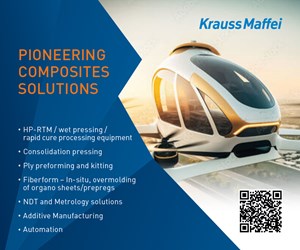Vertical Aerospace completes Phase 2 piloted flight testing
VX4 eVTOL aircraft prototype begins untethered, piloted, thrust-borne testing following expansion of permit to fly from the UK Civil Aviation Authority.
Share
Vertical Aerospace (London, U.K.), in the middle of its piloted flight test program, has achieved Phase 2 which involved the company’s full-scale VX4 prototype advanced air mobility (AAM) aircraft undergoing piloted, untethered vertical takeoff and landing (VTOL) for the first time.
The VX4 prototype, powered by battery packs delivering up to 1.4 megawatts of peak power, surpassed expectations in hover performance, control and stability, the company reports. Testing will now progress to low-speed maneuvers using lift generated by the propellers at its Flight Test Centre at Cotswolds Airport, U.K. Thrust-borne flights are designed to assess the aircraft’s stability, battery efficiency, control characteristics, aerodynamics, structural and dynamic loads and performance across different speeds, enabling further assessment of how the VX4 behaves under real-world flight conditions.
This announcement marks a milestone in the VX4’s flight envelope beyond the initial tethered hover condition in Phase 1, as the prototype continues to operate under more demanding conditions, ensuring it meets the most stringent safety and regulatory standards.
The second of four testing phases follows the UK Civil Aviation Authority’s (CAA) expansion of Vertical’s permit to fly. To secure this expansion, Vertical submitted extensive documentation verifying the VX4 prototype’s safety under Phase 2 conditions. This included systems and structural validations, Phase 1 outcomes, flight test protocols, engineering specifications and detailed operational procedures.
“It’s great to see the VX4 throw off the tethers and move to the next phase of our piloted test flight program,” says Stuart Simpson, CEO of Vertical Aerospace. “We now enter a realm that very few companies in the world have achieved. Our team is thrilled with the significant strides we continue to make with the VX4 prototype as we expand our learnings and take another step towards connecting communities with faster, cleaner and safer travel.”
Vertical will now progress through Phase 2 while working with the CAA to extend its permit to fly and move onto Phase 3 — wingborne flight tests. This next stage will involve piloted takeoff, flight, and landing like a conventional aircraft using wing-generated lift. The primary focus of this phase is expanding the transition envelope as safely as possible, working down in speed from high altitude rather than up in speed from low altitude, which Vertical says is much safer. Phase 4 will involve transitioning between thrust-borne and wingborne flight modes.
Vertical is currently developing an identical full-scale prototype which will accelerate the VX4’s flight test program and demonstration capability. Once assembled, the company will take what is learned from flight test from both prototypes into the design and development of the certified VX4 model.
Related Content
-
Hexagon Purus opens new U.S. facility to manufacture composite hydrogen tanks
CW attends the opening of Westminster, Maryland, site and shares the company’s history, vision and leading role in H2 storage systems.
-
Midnight production aircraft completes full transition flight
This is Archer’s second full-scale eVTOL aircraft to achieve this milestone, critical to being able to carry commercially viable passenger payloads.
-
Composites opportunities in eVTOLs
As eVTOL OEMs seek to advance program certification, production scale-up and lightweighting, AAM’s penetration into the composites market is moving on an upward trajectory.





